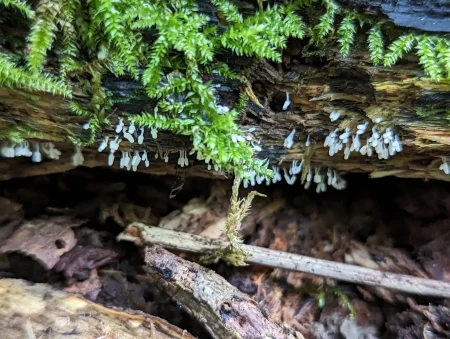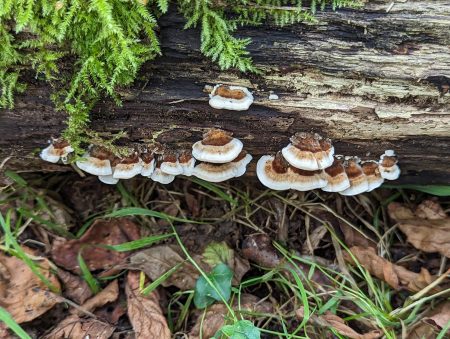Today was warm and relatively dry with a cool breeze.
ENTRANCE AREA
The Agaricus group at the Entrance Yard had disappeared, but at the reserve entrance I found the unidentified species from before, as well as a Datronia species on a lichen-encrusted piece of wood (Fig. 7.0).
The Tricholoma album from Day 5 found off the path to Basecamp had also disappeared.
BASECAMP AREA
In the Basecamp Loop, on the same log from before, I found the parasitized Cribraria argillacea, as well as some small pink Stemonitis (Fig. 7.1).
The Fuligo cinerea from previous weeks had completely disintegrated into spores and there was no sign of the Metatrichia, the Stemonitis species nor the Peziza by the path.
At the log circle in Basecamp, the Candolleomyces candolleanus had also gone, but the Ramaria stricta behind the activity tent had grown larger.
THE DELL
In The Dell I found a small group of Arcyria cinerea (Fig. 7.2) and the draping Fuligo septica had turned into a spore mass.
The Hemitrichia clavata had diminished.
Inside the branch circle I found an uprooted Russula ochroleuca (Fig. 7.3) and what may have been Paxillus involutus (Fig. 7.4).
On a log near The Dell entrance I found two slime moulds: Reticularia lycoperdon (Fig. 7.5) and a tiny Lycogala epidendrum (Fig. 7.6) on some wood material.
I also spotted a piece of green-stained wood indicative of Chlorociboria, but there were no fruit-bodies.
Arcyria cinerea
The Dell

Figure 7.
Russula ochroleuca
The Dell

Figure 7.
Paxillus involutus
The Dell

Figure 7.
Reticularia lycoperdon
The Dell

Figure 7.
Lycogala epidendrum
The Dell

Figure 7.
SANDY GLADE AREA
In the Sandy Glade clearing, I saw Trametes versicolour (Fig. 7.7) and the Hemitrichia clavata from previous days.
Whereas the H. clavata group in The Dell had diminished, this group of H. clavata had grown larger.
On the same log as the H. clavata, I spotted a small group of dull pink slime mould that I now know to be a juvenile form of H. clavata.
Here I spotted another Reticularia lycoperdon (Fig. 7.8), as well as a scattered group of Leucocoprinus brebissonii.
ENCLOSED AREA
In the Enclosed area, there was still an abundance of Collybiopsis ramealis, as well as a large Hygrocybe conica (Fig. 7.9) under the central Birch.
Nearby, I spotted a group of small-capped, large-stemmed fungi which may have been Tricholoma fulvum (Fig. 7.10).
Again, Leotia lubrica grew everywhere, and the same coral-like fungi were still there: Clavulinopsis species, Clavulina coralloides and the possible Clavaria species.
Further into the Enclosed Area, by the water channel, I found a weird growth which may have been Thelephora penicillata (Fig. 7.11) — the same fungus that I saw nearby on the woodland path on Day 1.
The Picipes badius remained the same as before.
YEW GROVE AREA
On the way to the Yew Grove, I spotted a Fuligo septica plasmodium (Fig. 7.12) which was forming an aethalium in some areas.
Along the sides of the path I saw groups of Inocybe geophylla (Fig. 7.13).
OUTPOST AREA
Most of the Fuligo aethalia at The Outpost area had gone into masses of spores, though I found a Fuligo septica in an aethalium-forming stage.
I also found another green-stained piece of wood, this time with Chlorociboria fruit-bodies (Fig. 7.14).
TRAIL END AREA
Many more Fuligo septica were found in the Trail End Area, including the remains of those seen on other days.
I also saw the Arcyria cinerea from before and a Stemonitis group (Fig. 7.15) had grown on one of the log piles.
OTHER
The Scleroderma citrinum were prolific as usual throughout the woodland.
The Hydnum repandum was still around.









